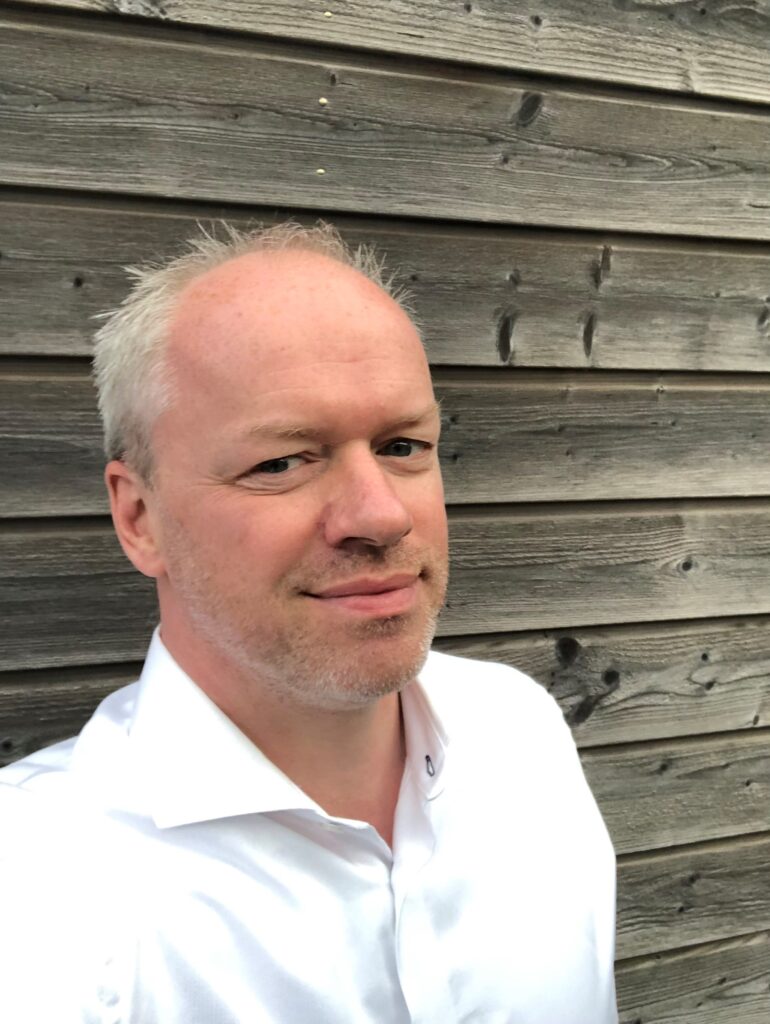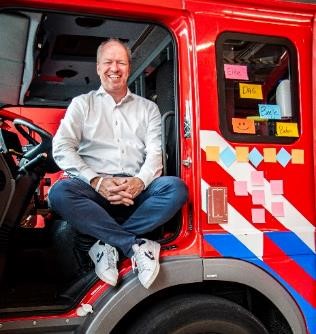“When it comes to sustainability, there are large and small steps to take. Starting with large steps may seem effective, but they can be daunting and can therefore limit people’s ability to contribute. And while small steps may seem insignificant at first, they can be a catalyst for larger steps with more impact. Taking and celebrating small steps makes the larger steps possible. With smaller steps, people are more likely to believe it’s possible and to try it out.”
Meet Ian Helgering, Program Manager at the Amsterdam Amstelland Safety Region – the public body that facilitates regional cooperation in dealing with crises, disasters, and disruptions of public order. He is inspired by people who take responsibility and act. And that is exactly what he tries to do himself in the area of sustainability. This stems from a burning desire (no pun intended) to pass the planet on to future generations. A course he took with André Nijhof, Professor of Sustainable Business and Stewardship at Nyenrode Business University, further fueled his thinking about creating a movement for sustainability at work.
Fostering individual initiative
“The Green Office initiative has been around since 2022. Originally run by three senior directors potentially made it powerful, but at the same time deterred people’s initiative. So I raised my hand to lead it more inclusively, to create a movement with engaged employees across the organization. Now, we’re letting a thousand flowers bloom, asking people to spread sustainable steps in whatever way they see as relevant for the organization. Senior leadership is still engaged but in a different role. They are really supportive and they are bringing in perspectives from partners, like the municipality of Amsterdam.
In the new set-up, we’ve set ourselves three goals as the Green Office:
- Find the people engaged with sustainability, and make them visible and connected;
- Using their stories, touch the hearts and minds of the people who are not engaged yet;
- Support initiatives with the limited means we have available.”
Creating a movement through the Green Office
“By framing it as a movement, we get people involved, we collaborate with smaller steps and simultaneously overcome resistance. As you can imagine, switching to vegetarian catering overnight is not a popular message in a fire station. But by starting with easier switches (like vegetarian snacks) and collaborating with the staff, we’ve come a long way already.
Great examples that we find – large and small – are shared on an intranet page, to inspire the wider organization. We even have a bit of budget available to support new initiatives, especially if they are newsworthy. We want to showcase sustainable initiatives and the people who started them from intrinsic motivation. To inspire others to take steps as well.“
Communication plays a key role in touching the hearts and minds of people within and outside of the organization. I regularly speak about the many sustainability initiatives at events. Also, some people in our leadership team are quite vocal about sustainability. But it is also crucial to listen to each other, to understand barriers to change, and to find joint solutions.”
Directing initiatives towards shared goals
“To ensure the movement of individual initiatives adds up, we’ve created a shared agenda for 2030. This clarifies the organization’s key sustainability goals. So our employees know on which topics we are looking for ideas and contributions from around the organization. It also helps us connect with peers, like other fire departments, and learn from what they are doing. And perhaps to establish new partnerships, such as insurance companies on fire prevention.
The topics on our shared agenda supplement the changes required by legislation and external commitments, like phasing out fossil fuels. The changes required to make our buildings and fleet more sustainable are embedded in the associated teams within the organization. Some of these pilots and programs are quite visible, like the pilot with the electric fire truck in 2022. After a large investment, the Amsterdam fire department was proud to be one of the first in the world to have an electric fire truck. Everyone loved it when it was up and running, but as it was very new, we also had to deal with several teething problems. The renovation of the oldest fire station in the country is another great example. Fire station “Dirk” not only improved its looks and comfort but also its energy label. It has many solar panels and no longer uses natural gas. And it has been nominated for the sustainable heritage restoration project of the year 2023. Neither the electric truck nor the sustainable restoration project were part of the green office, but it’s great to work with people around the organization to develop additional initiatives.”
Leading change
Ian has a strong track record in digitalization, change, and social innovation, helping to reinvent how to best work together in organizations. Inspired by André Nijhof’s course during his Nyenrode MBA program, he is now adding sustainability to his toolbox. “It all fits together quite well. My earlier work focused on lean – now I’m adding green! It’s all about reducing waste, complexity, and redundancy – and about engaging people.”
Leading the Green Office comes on top of Ian’s role as Program Manager. “It does seem like a lot, but it’s fun and inspiring to do which makes it easier to keep going. I don’t need to do all the work myself. My role is all about helping others find relevant opportunities for sustainable change. And it may be time to add a bit of competition as well, highlighting which fire station has contributed the most to the sustainability agenda!
Sometimes it is hard to see progress. Zooming out helps me to see that change is taking place and to acknowledge the people driving change. It also gives me some space to dive deeper into a topic, to think about future generations, and to wonder about what is really needed. Sometimes zooming out is hard work, but often it takes just a small step, like walking in nature to realize how beautiful our world is. And small steps help to pave the way for larger steps.“
Elemental steps for sustainable change
Ian’s next step is to share his learnings beyond the safety region as well. His startup Elementries helps organizations to eliminate obsolete, outdated, and redundant routines and systems from operations – improving both the business, the capacity to grow, and sustainability performance. “I want to release companies from the restrictions that weigh them down, so they can focus on the useful elements. Keeping fewer things up and running reduces their footprint and gives space for innovation and growth (green growth). That in turn creates room to enhance the handprint – the positive sustainability impact.”
To find out more about Ian and his work inside and outside of the Amsterdam fire stations, follow him on LinkedIn. Interview by Marjolein Baghuis for the Change in Context blog. To read interviews with other interesting people, book reviews, and other posts about change, leadership, and sustainability, please subscribe.



